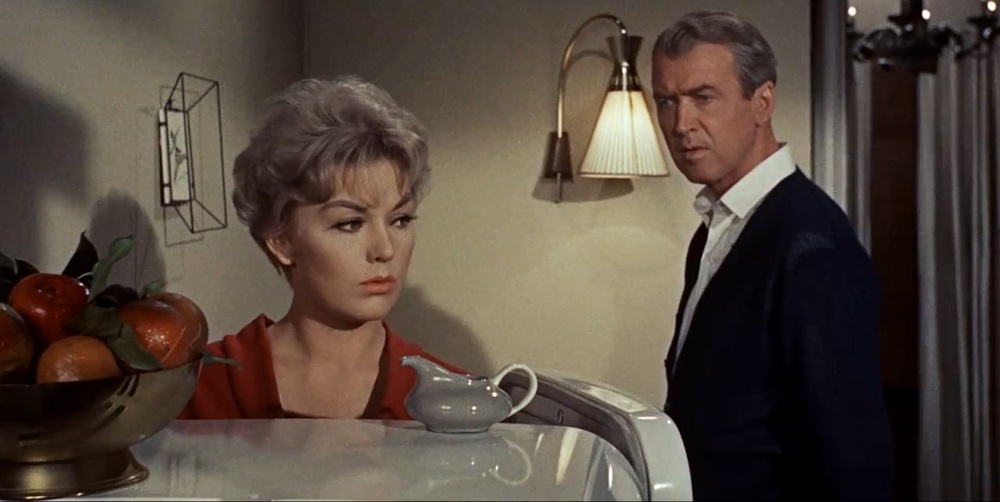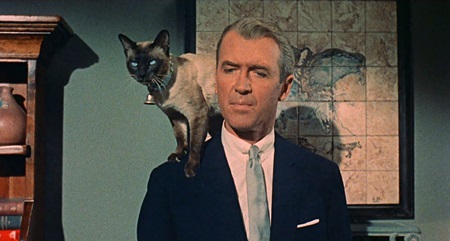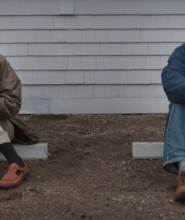
Unforgettables: Cinematic Milestones #23 – Bell Book and Candle (1958)
by Sara Michelle Fetters - December 13th, 2023 - Features
Magic, romance, and happy memories make Bell Book and Candle a timeless cinematic wonder
NOTE: This feature originally appeared in the November 17, 2023 edition of the Seattle Gay News.
Is 1958’s Bell Book and Candle the greatest Christmas-set supernatural rom-com ever made? Probably, and that’s not because it’s one of the small handful that have ever been made. No, its greatness has more to do with screenwriter Daniel Taradash’s sublime adaptation of John Van Druten’s play, the dexterous handling of the loopily inventive material by director Richard Quine, and the great James Wong Howe’s lush and visually vital Technicolor cinematography.
Most of all, it is thanks to the stellar performances by the all-star ensemble. James Stewart. Kim Novak. Jack Lemmon. Ernie Kovacs. Elsa Lanchester. Janice Rule. Hermione Gingold — they’re all perfect, each slipping so easily into their roles that it’s (forgive me for saying this) magical. I could watch them deal, each in their own way, with all of this bewitching romantic skullduggery for weeks on end without ever tiring, and there’s not a single moment I’d ask the filmmakers to change if I could go back in time and do so.
Gillian Holroyd (Novak) is a modern-day witch who runs a high-end curio and antique shop in a quaint New York neighborhood. Shepherd “Shep” Henderson (Stewart) runs a publishing house and has recently moved into a swanky apartment in the same building. Gillian has her eye on Shepherd but initially decides she won’t use her mysterious powers to get him to feel amorously toward her. Then she learns his fiancée is Merle Kittridge (Rule), a snooty former classmate from her university days, and all bets are immediately off.
Lemmon gleefully hams it up as Gillian’s musically curious warlock brother Nicky, while Lanchester is their daffy best friend and fellow enchantress, Queenie. Kovacs is drunken author Sidney Redlitch, mysteriously drawn to New York for reasons he cannot quite explain. Together, these three — both intentionally and by unknowing accident — are the primary catalysts that fuel Gillian’s spell-casting on Shep, which sets the witch down a path that could eventually lead to the loss of her powers, probably for good.
It’s all pretty silly, and Quine isn’t the subtlest of filmmakers. But with a cast this outstanding and subject this richly layered and exquisitely character-driven, his straightforward approach suits the material wonderfully. Quine plays up Novak’s otherworldly beauty whenever he can, and signature scenes of her staring straight into the camera — while holding her devilishly lithe black cat Pyewacket as the audience becomes Stewart’s stand-in — are sublime.
This also means the director lets his cast cut loose in ways that play to each of their comedic abilities. Lanchester adds an aura of lethally dotty charm, her whimsical theatricality a divine counterpoint to Novak’s far more grounded performance. Lemmon never holds back. It’s clear Nicky has a lust for life and adores being a warlock, and whether it’s playing bongos at the Zodiac Club, turning frost-covered street lights on and off at will, or cowriting a tell-all book about the mystical arts with Sidney, his mischievous joy is continually infectious.
Surprisingly, I came to Bell Book and Candle through my great-grandmother on my father’s side. They resided in Lebam, Washington, a small logging community a few hours outside of Seattle, on the way to the Pacific coast. When I was little, each time I went over for a visit, we’d stand back-to-back to see how much I’d grown since the last time we’d seen one another. She lived directly across the street from my grandparents in the middle of backwoods nowhere, and it was the cutest little place you’d ever hope to see. Inside, you’d swear you’d stepped back in time.
Even from a quite young age, my love of cinema was clear. While I can’t say this was ever something my great-grandmother particularly understood (or even supported, for that matter), she’d still listen to me speak about Star Wars or The Black Stallion or Raiders of the Lost Ark or even The Wizard of Oz for hours on end without ever appearing to grow bored or tired, which I imagine wasn’t easy, considering the typical stream-of-consciousness ramblings of your average seven-year-old.
I barely remember how or when we watched this one together; I can only say with absolute certainty that we did. It was the Christmas holiday, and I’d just trotted across the street to hopefully get a chocolate or a piece of taffy from her not-so-carefully hidden candy drawer in the kitchen. Somehow this movie was on the television, and I was immediately spellbound. We ended up watching the entire thing together, sharing a comforting hug right near the end, just as my father rumbled through the door, wondering what the heck had happened to me and stating that I shouldn’t be bothering great-grandma so near my bedtime.
In the years since, I’ve grown to adore Bell Book and Candle for reasons that go far beyond this treasured memory. Stewart and Novak’s chemistry is off the charts, and Wong Howe’s use of color — especially a seemingly never-ending series of captivating blues and mesmerizing greens — is breathtaking. I’m also constantly amazed by how Taradash takes the inherent theatricality of Van Druten’s source material and makes it feel so spontaneous and electrically alive. It’s all incredible.
But as preternaturally superb as Novak’s eyebrows may be, and while I will always lust over each of designer Jean Louis’ glorious gowns, I cannot watch this film without recollecting my great-grandmother. I smell her snow-white hair. I hear the faint shuffle of her feet sliding across the carpet. I see the steam rising off the wood-fire boiler resting in the corner of her tiny living room. I even shed a happy, silent tear while diving back into our shared past right here as I write these words.
This is the power great cinema can have. It sparks something inside of us, a primordial sense of togetherness that can transcend space and time, reducing us back into our childhood selves instantaneously. Bell Book and Candle does this for me. It casts a powerful spell, one that enchants new viewers across generations whenever — like magic! — it is conjured up for viewing.
Celebrating its 65th anniversary, Bell Book and Candle is available on DVD and Blu-ray. It is not currently streaming.






